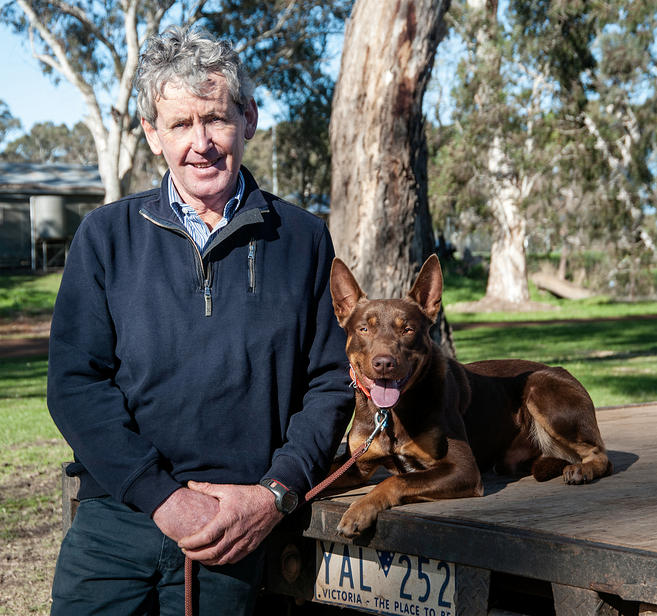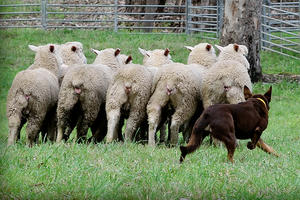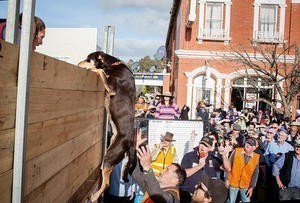I looked at a cosmos example and sought to copy its style best I could using our tools (and in article css) the width of their content site is huge so it will obviously look smaller. Lets see how well I can do.

What smart dogs can teach us
Australian kelpies have been bred to think for themselves. Could finding the genes that make them tick shed light on the way our brains work? Hazel Flynn and Elizabeth Finkel report.
Inside the stockyard, eight nervous white sheep freeze or flow at Balgalla Bart’s command. Trainer Ian O’Connell is watching. The laser focus between dog and man never falters. O’Connell moves his head slightly; occasionally a hand emerges from the pocket of his well-worn jeans to signal with a tight gesture.
Bart sees it all without ever seeming to shift his attention from the flock, backing away or racing to the head of the mob as required. Now and then O’Connell issues a terse whistle or word. No more is needed. Balgalla Bart is assessing and responding, not mechanically waiting for orders.
Bart, a handsome 20 month old black and tan kelpie, and his renowned trainer are running through their paces before hundreds of onlookers at the Australian Kelpie Muster, an annual event in the tiny town of Casterton 350 kilometres west of Melbourne. The crowd can’t help but be awed by the sight of this dog – even experienced observers such as breeder Chris Malcolm and trainer Daniel Ball. “You watch them working, and they actually think. They don’t just follow instruction,” says Malcolm. Ball agrees there is something extraordinary about kelpie intelligence. “Border collies keep asking questions: ‘Is that what you want me to do?’ Kelpies go, ‘So you want the stock moved from there to there? OK.’ And then they start figuring out how to get it done.”
Not all dogs have this ability to problem-solve; it has been bred into the kelpie by concentrating particular genes. Now Australian researchers are trying to identify them – not only to breed better kelpies but also to shed light on how something as intangible as behaviour can be writ large in DNA.
Casterton nestles in a valley surrounded by fertile hills dotted with sprawling flocks of grazing sheep. The kelpie was first bred here to keep these unruly flocks under control. In 1871 grazier George Robertson of nearby Worrock station mated two black and tan collies brought from Scotland. One of the female puppies drew the eye of Jack Gleeson, a doughty drover at a neighbouring property. A deal was finally made: the pup for one of Gleeson’s stockhorses. On the bank of the Glenelg River in the dead of night, pup and horse were traded. Gleeson gave the pup the Celtic name for water spirit: Kelpie.

The young stockman moved to New South Wales where Kelpie produced several litters, some sired by an all-black collie, others by a red one. One of the pups, named for her mother, tied for first place in the country’s inaugural sheepdog trials at the 1879 Forbes Show. Word spread and soon the description “Kelpie’s pups” was replaced by the general term “kelpie” for any similar dog.
For Malcolm, an elegantly dressed entrepreneur who grew up in Zimbabwe, this story brings Australia’s past to life. Leaning forward, eyes sparkling, he sketches the scene in his modulated accent. “Think back to that time. Australia was built on the sheep’s back. Can you imagine what it would be like if you had bred those dogs? It would be like inventing a tractor when everybody else is ploughing by hand. In the way the steam engine changed the industrial world, that kelpie changed the farming world overnight.”
But not all kelpies are created equal. To discover why, a team from Sydney University Veterinary Science Faculty led by Paul McGreevy and Claire Wade is carrying out the Farm Dog Project. Funded by Meat and Livestock Australia to the tune of half a million dollars, it aims to identify the most desirable traits in working dogs and locate their signature in the dog’s DNA.
"In the way the steam engine changed the industrial world, that kelpie changed farming."
For most of the 30,000 years or so since wolves first made themselves welcome at our campfires, dog breeding has been an art. Armed with a DNA map of traits as a guide, it is set to become a science. An estimated 300,000 farm dogs work in Australia and their breeders are keen to learn what they can from other industries. For instance DNA-assisted breeding has been worth $20 million a year to the Australian dairy industry alone.

Malcolm has seen the successes of science with the prize-winning cattle he breeds as a hobby in Victoria’s Yarra Ranges. He first acquired kelpies to work with the cattle but then they too became a breeding passion. One of his pups achieved a record price at Casterton two years ago. “Part of the excitement is finding a [genetic] match that creates something quite extraordinary,” he says.
"She just wants to do whatever it is you are asking of her and she will do it to the nth degree."
Casterton is a classic Australian country town with a main street wide enough to drive three tractors abreast, shade offered by the shops’ bullnose verandas and nothing taller than the two-storey historic pubs. The 1,800-strong population grows to a festive 10,000 during the muster weekend. Families and owners of pet kelpies flood in for the Saturday fun day, with sprint, high-jump and hill-climb competitions to test their dogs’ strength and stamina and crowd-pleaser novelty events such as kelpie pinball, where ducks are herded through a course.
After three years of coming second, Daniel Ball and nine and a half year old Denny finally triumph in the 2015 pinball. The dog also gives her all in the 50-metre dash and the hill climb, events she won in her younger years. The climb has the dog handlers standing on the lip of a hill so high it affords views of the entire district, and so steep they lose sight of their animals as soon as they begin their gallop to reach them. All they can do is call continuously at the top of their lungs, hoping the dog is still following the sound of their voice. This year Denny doesn’t place, but that she made it to the top says everything about her as an exemplar of the breed: “She’s got heart and stamina. She just wants to do whatever it is you’re asking of her and she will do it to the nth degree.”
Sunday, auction day, is when the event becomes serious. There are three categories: pups three months and under; ‘started dogs’, with some training aged three to 12 months; and ‘fully trained’ dogs, usually over 12 months. Some breeders bring seven dogs or more to sell.
O’Connell is here to sell Bart. Born to the farming life, O’Connell is fit, lean and weathered, with blue-grey eyes that seek the horizon. He now splits his working life between farming sheep and training people to handle working dogs; around 500 people a year take his courses. He also breeds kelpies – selectively. “Perhaps two litters a year. I’ve got this thing about quality not quantity,” he says. “My hobby is to find the perfect working dog. I hope it never happens, otherwise I don’t know what I’m going to do with the rest of my life.”

They might not be perfect yet, but the dogs O’Connell breeds are exceptional as evidenced by the top auction prices he has claimed over the years. Sitting on the back of his ute, O’Connell affectionately rubs Bart’s handsome head. Bart’s brother Balgalla Coke topped the 2014 auction, selling for $10,000.
Calm and relaxed in the lead up to the auction, which has drawn a paying crowd of 3,000, O’Connell has set Bart’s reserve at $5,100. He says: “If he doesn’t make that I’m only too happy to take him back with me. I just want him to go to a good home. I’ve spoken to a lot of people about him and I’ve told some of them they won’t suit him.” So what kind of owner-handler would be suitable? “Someone that understands traits, which is hard to find.”
"I see amazing dogs who have all those wonderful traits but the handler’s got no idea."
The Farm Dog Project team has homed in on 10 traits. O’Connell focuses on six: “The most important one is heading instinct, which most kelpies have. That’s the desire to get to the head of the stock: if stock are trying to escape they do whatever it takes to get to the head, turn it, and bring it back to me. Then there’s calmness, so they’re not what we call ‘fizzy’.
“Presence is another big trait I look for. It’s an aura: stock just don’t like being near a kelpie with presence. And that makes them a great work dog, because you put a kelpie in a paddock and the stock move away from it. If a kelpie’s got the calm trait and it’s got great presence, well, it really doesn’t have to do an awful lot. It will work all day without wearing itself out.”
Backing, O’Connell explains, is the willingness of a dog to jump up on the back of sheep and run over them to control their movements, while barking is, as you’d guess, the dog’s use of its voice to control stock. “The more of these good traits you’ve got in a dog the less you have to really train them. For a dog with all the desirable traits there are only two things you should have to teach it. One is to cease work and the other is to get it to go left or right: ‘brakes’ and ‘steering’.”
Different traits are required for different jobs – from the close, tight work of moving stock through narrow runs and on to trucks to the much greater coverage required in a paddock. This is where casting is needed. The handler can send the dog off to round up sheep at a significant distance, knowing it will go wide to get behind the animals without spooking them while ensuring the mob doesn’t break up.
The casting trait comes from the breed’s two distinct forebears, says Nancy Withers, who manages to look elegant in a bush hat and dusty boots and exudes an air of easy authority. Her 40 years as a breeder have given her an encyclopaedic knowledge. “The original kelpie family were mostly what were called hill gathering or North County collies from northern Scotland. They would work a long, long way away from the shepherds. They were independent and you could trust them to work with sheep alone.”
Not having the casting trait doesn’t make a dog inferior – it just means it won’t suit paddock work. Bart is a good example, O’Connell says. “He’s a very confident dog. He loves backing and barking. But he hasn’t got the trait of casting, so he’s going to be a dog for working in trucks or sheds or yards where he can be in amongst them.” That’s fine with Angus Kirton, a merino farmer who finally secures Bart with a winning bid of $11,000. Kirton paid $6,000 for an O’Connell dog in 2009. Kelpies, he says, are “worth more than 10 men” on his property. The Farm Dog Project team estimates a working dog is worth at least $40,000 to a farmer over its lifetime.
In Bart’s case, stud service fees are likely to add to that return. But sharing a bloodline doesn’t necessarily mean sharing traits. “In one litter of six pups you might have two that work a bit more towards the paddock, two that might work a bit more towards the yard and some perhaps in between,” says Withers.

One of the Farm Dog Project’s biggest challenges was how to manage subjectivity when assessing a dog’s traits. Take ‘eye’, for instance. This is the way the dog holds a sheep’s gaze. O’Connell explains: “If you’re out in the paddock you definitely want a dog to have eye so it can fix its gaze on an animal that’s tending to want to break away. But not too much, otherwise it becomes ‘sticky’ – fixated on one animal. If I’m scoring eye, ‘one’ would probably be no eye whatsoever and ‘five’ would be very, very sticky – they’d just look at a sheep or cow for hours if you let them.”
O’Connell’s scoring system is based on a lifetime of working with kelpies. But it’s also subjective – which can be a problem for geneticists such as Wade. Her goal is to map a trait to a precise stretch of DNA. But if the trait is imprecise to begin with, it could send her on a wild goose chase. “One of the things we’ve looked at is whether when one person says ‘eye’ they mean the same thing as someone else who says ‘eye’,” Wade says. “While people think they’re talking about the same thing they’re not always, and we needed to be really careful of that. We describe the things we’re asking for so that people respond on a level playing field.”
So do breeders think science will help them breed better kelpies? It’s potentially very promising, says O’Connell, “but it’s only half the story; in fact not even half. I see amazing dogs who have all those wonderful traits but the handler’s got no idea what they’re doing. If we’re going to spend all this time and money discovering these traits we’ve got to spend a lot more time teaching handlers how to work dogs correctly.”
Joe Spicer has been breeding kelpies for more than 20 years. He puts the breakdown of genes and training at 50:50. He’s sceptical about the value of genetic analysis because “there are so many traits that negate each other. Eye, for example. The more eye a dog displays, usually the less bark it has. We’re trying to breed dogs with different types of instincts, many that counteract each other.”
Ball, who has owned pound-rescue kelpies and pure-bred dogs, puts his guesstimate at 60:40 “or maybe even higher for genetics”. Malcolm agrees that “genetics play the biggest part in animals … I think the genetic mixing is probably 70% of the key factor in dogs and the other 30% is the environment.”
Withers, with her strong recall of many generations of dogs, goes further: “I can remember seeing certain work patterns. And if a pup, the first or second or third time it sees sheep, shows for a split second a trait that you know its ancestor however many generations away had, then you know it’s got it too. I say my dogs are 85% genetics, 15% training.”
And what of Claire Wade, the Farm Dog Project’s expert geneticist? “I expect what we see is about 20 to 30% ‘genes’ and the remainder is what would be regarded by as a geneticist as ‘environment’.” But, she points out, this is as high as many of the traits that sheep breeders select for. “You can do a lot with 20 to 30%.” And for Wade, finding these genes for behaviour and intelligence won’t just help kelpie breeders. “It will help us understand ourselves; for me that’s the most interesting part.” - Hazel Flynn
eh not bad. There is obvious alignment issues due to the different canvas size, and of course the fonts were different (they use proprietary something or other). But other than that -- with the very tools at your finger tips. I was able to copy a pretty unique article style.